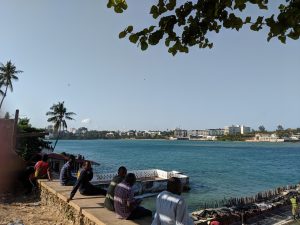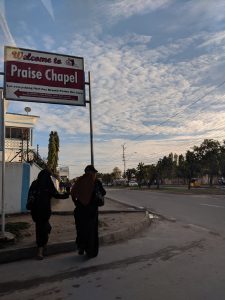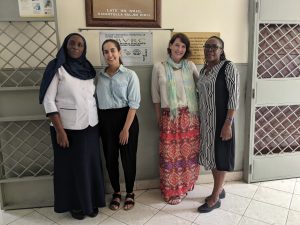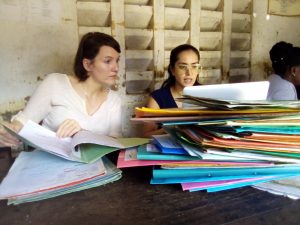By Julia Green
After our whirlwind day in the Hague, Jenna and I were able to spend a night with Jenna’s relatives in Nairobi before our flight to Mombasa the next day. The side of Nairobi I saw during my first day and a half in Kenya seemed comparable to many other large cities I’ve visited. I saw tall buildings, nice restaurants, large shopping malls and people milling about in stylish clothes as they went about their days. Since we arrived during Kenyan wintertime, even the weather, which was about 15 to 20 degrees, was not the scorching heat I imagined. Everyone we interacted with was completely punctual, defying the expectation of “African time” I had been warned would be the norm. Given that the two other times I have lived abroad it was in countries where very few people spoke English, I think I was even thrown off by the fact that I could communicate perfectly with everyone I met. As I boarded the flight to Mombasa after our short stay in Nairobi, I found myself wondering if I would actually experience the culture shock I expected during my first time in Africa.

From the moment we arrived in Mombasa, however, it was clear that Kenya’s second largest city has a completely different vibe than the capital. We spent our first weekend there using the daylight hours to take in the sights: shanties and open-air markets, groups of men running with heavy rickshaws of fruit, packs of skinny cows holding up traffic, and of course, the beautiful blue water of the Indian Ocean.
The roads, most of which were unpaved and quite bumpy, seemed to be governed by an unspoken code of chaos that allowed cars, tuk-tuks, and “boda-boda” motorbikes to smoothly manoeuvre around each other with only the occasional honk despite the absence of traffic lights. Members of the nomadic Maasai tribe, adorned with handmade jewelry and wearing their brightly-coloured shukas(a toga-like linen garment), walked amongst the crowds of people in Western clothing with their wooden staffs in hand.

In Mombasa, income disparity between the different classes was also more apparent. As we sat in traffic (and boy, does Mombasa have traffic) many forlorn-looking street children came to the window of our car begging for money. Minutes later, before we could even process the poverty, we would drive past a luxury resort glamorous and excessive enough to be considered fit for the wealthy Kenyans and foreign tourists that frequented it. The city was extremely humid, reaching temperatures of 30 degrees during the day and only dropping to about 27 or 28 at night. According to locals, the heat was part of the reason why everyone was consistently late for every engagement – in Mombasa, we definitely experienced the more relaxed attitude towards punctuality we had been told about. Despite any inconveniences caused by the chaos, the heat, or the poverty though, everyone we met seemed to be relaxed and happy. On Sunday we could hear the peaceful calls to prayer from several nearby mosques competing with the loud, joyful songs that floated out of the churches.

On our first day at the International Centre for Reproductive Health Kenya (ICRH-K) we met with the organization’s acting director as well as the team’s in-house lawyer who we would work closely with during our time there. The four of us discussed mine and Jenna’s educational and professional backgrounds, as well as what we were hoping to get out of the internship. By the end of the meeting we had come up with a rather ambitious project: we were going to look at all the cases of gender-based violence reported to the local hospital’s Gender-Based Violence Recovery Centre (GBVRC) from the past six years and find out how many of them wound up getting legal justice in the courts. For all of the cases that didn’t result in a conviction, we planned to get to the bottom of why they had fallen through the cracks.

In retrospect, I don’t think that any of us sitting in that meeting room on our first day realized just how much work would be required to bring this project to fruition. When we got to the hospital, we discovered that there was no centralized, digitized database for all of the patient files. Instead, all the patient records were kept in a locked storage room in binders that appeared to have no rhyme or reason when it came to their order on the shelves. Despite how confusing the filing system seemed to us, the nurse and paralegal from the GCVRC somehow knew exactly where every file was and were always able to help us find what we needed in a matter of minutes. Slowly but surely, we worked our way through the hundreds of handwritten files and entered information we deemed to be relevant into a carefully crafted Excel sheet.
It took us just over a month to go through the nearly 4,000 cases that had been reported to the hospital between 2013 and 2018, but our work didn’t stop there. After we had collected the data from the GBVRC we started visiting all of the local police stations, where we asked if we could go through their sexual offence files to see how the cases had been handled. Because of the reputation of the equality effect, the Canadian non-profit our placement was organized through, the police response to us was for the most part agreeable. There were a few administrative hurdles we had to get past in order to get what we needed at some stations, but by the end of July we managed to work through almost all of the sexual offence files that the eight Mombasa police stations could produce for us.
While we carried out the data collection, we also conducted interviews with relevant parties including police officers, counsellors, health professionals and even a local magistrate (judge), all who work closely with

survivors of sexual violence. Jenna is an Excel whiz who used her skills to crunch the numbers from our data sets, and I put my journalism degree to work as I transcribed the interviews and carefully documented any observations we made as we visited the police stations. All of this information came together to give us a clear picture of challenges in the justice system for cases of sexual violence. The quantitative and qualitative research we conducted allowed us to see clearly where improvement was needed to increase convictions, and also gave us some ideas for initiatives that could help to deter perpetrators from committing sexual violence in the first place. The end result was a comprehensive draft of a report almost 50 pages long that we were able to send to the ICRH-K to help guide their future work with survivors of gender-based violence. Before we left Mombasa, we had the opportunity to present our findings at a journal club, a monthly event where researchers from local universities and non-profits come together to share what they have been working on. In many ways, it felt like we had completed an entire thesis project in just two short months.
When I look back at our time in Mombasa, I still find it incredible to believe how much we accomplished in so little time. Because I had worked in non-profit before and know how common it is for interns to be forgotten or underused, I had fairly low expectations for the work I would do over the summer. Happily, my expectations for my time in Kenya were once again defied. I can already see all the ways that my time with the ICRH-K Kenya will make me a better student, a better researcher, and down the line, a better lawyer. Most importantly though, I know that the lessons I learned in Mombasa have helped me to better understand the many human rights challenges that persist around the world. I came away with an understanding of gender inequality, poverty, and corruption that I simply could not have gotten in a classroom or from a book. Throughout the summer I found myself constantly thinking about how grateful I was to have such an incredible opportunity through my studies at McGill.
